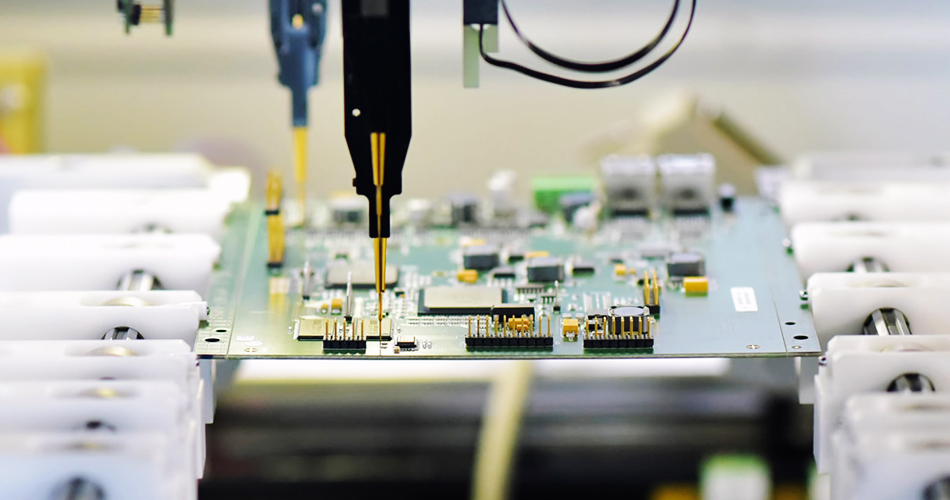- English
- Español
- Português
- русский
- Français
- 日本語
- Deutsch
- tiếng Việt
- Italiano
- Nederlands
- ภาษาไทย
- Polski
- 한국어
- Svenska
- magyar
- Malay
- বাংলা ভাষার
- Dansk
- Suomi
- हिन्दी
- Pilipino
- Türkçe
- Gaeilge
- العربية
- Indonesia
- Norsk
- تمل
- český
- ελληνικά
- український
- Javanese
- فارسی
- தமிழ்
- తెలుగు
- नेपाली
- Burmese
- български
- ລາວ
- Latine
- Қазақша
- Euskal
- Azərbaycan
- Slovenský jazyk
- Македонски
- Lietuvos
- Eesti Keel
- Română
- Slovenski
- मराठी
- Srpski језик
Electrical testing in PCBA processing
2024-11-05
PCBA processing (Printed Circuit Board Assembly) is the core link in manufacturing high-performance electronic products, and electrical testing is an important step to ensure the performance and quality of PCBA boards. This article will discuss in detail the electrical testing methods, key technologies and common problems in PCBA processing in order to better understand and implement this key process.

The significance of electrical testing
Electrical testing plays a vital role in PCBA processing. Its main purpose is to detect whether its electrical performance meets the design requirements after the PCBA board is assembled, and to troubleshoot potential defects and failures, so as to ensure the final reliability and stability of the product. Electrical testing can effectively reduce the failure rate, improve product quality and enhance market competitiveness.
Common electrical testing methods
1. Flying probe test
Flying probe test is a non-contact test method that uses a flying probe tester to detect the electrical properties of the PCB board, such as conductivity and short circuit. Its advantages are that it is suitable for small-batch production and complex circuit design, and has high test flexibility.
Functional test simulates the operating state of the PCBA board under actual working conditions and measures its functional performance such as signal transmission and data processing. By inputting signals or power, the various parameters of the board are detected to ensure its normal operation in a complex environment.
3. Burn-in test
The burn-in test is suitable for PCBA boards that need to be pre-written with firmware. By writing the firmware into the chip, the correctness of the program operation is verified. This test can detect firmware-related problems in advance and avoid failures caused by software defects after the product is put on the market.
Key technologies and equipment
1. Automatic test equipment (ATE)
Automatic test equipment (ATE) realizes comprehensive automated detection of PCBA boards by integrating multiple test methods. ATE can complete complex electrical performance tests at high speed and precision, improving detection efficiency and accuracy.
2. Image detection equipment
The image detection equipment uses a high-resolution camera to perform appearance inspection on the PCBA board to check for appearance defects such as solder joints, lines, and component positions. Image detection is usually performed before electrical performance testing to ensure physical and visual integrity.
Common problems in electrical testing
1. Cold solder joints and cold solder joints
Cold solder joints and cold solder joints are common problems in PCBA electrical testing. They can cause poor circuit contact and affect the normal operation of the product. These defects can be quickly identified through flying probe testing and functional testing.
2. Short circuit and open circuit
Short circuit and open circuit problems can seriously affect the electrical performance of PCBA boards and even cause equipment damage. Flying probe testing and ATE can effectively discover and correct these electrical connection problems.
3. Parameter deviation
Parameter deviation refers to the difference between the actual measured value and the designed value. This is usually caused by component quality or installation process. Through functional testing and burning testing, electrical parameters can be adjusted and verified to ensure compliance with specifications.
Strategies for optimizing electrical testing
In order to improve the efficiency and effect of electrical testing in PCBA processing, the following strategies can be adopted:
1. Introduce automated systems
Use automated testing equipment to improve test efficiency and reduce human errors. The automated system can perform autonomous detection and data recording, which helps to quickly locate and repair problems.
2. Strengthen quality control
Strengthen quality control in all aspects of PCBA processing to reduce defects. Improve overall processing quality by optimizing soldering processes, assembly processes and component selection.
3. Training of professionals
Through regular training, improve the technical level and detection ability of testers. The technical quality of professionals directly affects the accuracy and efficiency of detection.
Conclusion
Electrical testing is the core link to ensure the quality and reliability of PCBA processing. By rationally using flying probe test, functional test, burning test and other detection methods, combined with automation equipment and strict quality control, the electrical performance and product quality of PCBA boards can be significantly improved. Continuously optimizing the electrical testing process will lay a solid foundation for the high quality of electronic products.
-
Delivery Service






-
Payment Options









